ELECTROHYDRODYNAMIC SPRAYING
by Anatol Jaworek and Andrzej Krupa
Electrohydrodynamic (EHD) spraying of liquids is a physical process caused by the electric force applied to the surface of liquid. The electrical shear stress elongates the liquid meniscus formed at the outlet of a capillary, to the form of a cone and/or a jet which next deforms and disrupts into droplets because of the electrical and mechanical forces. The droplets generated by the EHD method posses electrical charge, usually a few orders of magnitude greater than the elementary charge, that dramatically changes their EHD properties, like for example electrical mobility of aerosol particles. The electrohydrodynamic spraying extends the droplet sizes available from conventional mechanical atomizers to the lower range. In some cases the droplets can be smaller than 1 m m in diameter.
A growing interest in physical backgrounds of the EHD spraying is spurred mainly by its new applications such as painting, fuel atomization in combustion systems, emulsification, microencapsulation, crop spraying, charged droplets scrubbing etc., which are currently introduced into technological processes.
The spraying process at negative polarity differs from that at positive. At positive polarity the droplets are usually finer. The thread or jet elongating from the cone at the outlet of the capillary is much longer for positive polarity than that at negative.
The electrohydrodynamic (EHD) spraying of liquids is one of the effective methods for generation of charged aerosol. The surface of liquid subjected to an electrical stress deforms locally to an elongated jet which next detaches from the body of liquid and disintegrates into droplets. The geometrical forms of the jet and the ways it disrupts into droplets can be classified into the modes of spraying as summarised in the following Table.
Modes of EHD spraying
|
Pieces of liquid |
Liquid jets |
|
Dripping mode
Meniscus: semi-spherical.<\P>
Drop: spherical (sometimes with trailing thread or sibling). |
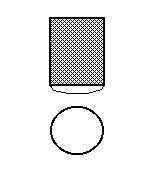
|
Cone-jet mode
Meniscus: cone (concave, convex)
Jet: simple straight linear.
Spray pattern: linear train/slim cone. |
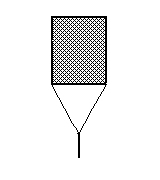
|
|
Microdripping mode
Meniscus: cone or hemispherical.
Drop: small spherical; (sometimes with trailing or leading thread). |
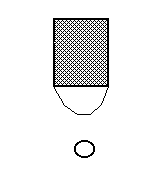
|
Oscillating-jet mode
Meniscus: skewed, oscillating cone.
Jet: linear, oscillating in a plane.
Spray pattern: ellipsoidal-base cone. |
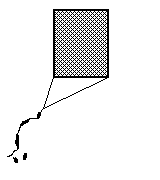
|
|
Spindle mode
Meniscus: cone or hemispherical.
Drop: elongated fragment of liquid (spindle). |
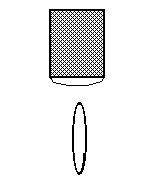
|
Precession mode
Meniscus: skewed, rotating cone.
Jet: rotating spiral.
Spray pattern: regular cone. |

|
|
Multispindle mode
Meniscus: flat or skewed cones.
Drops: multiple spindles
(with leading or trailing thread). |
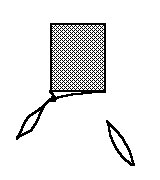
|
Multijet mode
Meniscus: flat, small cones on rim.
Jets: linear, multiple.
Spray pattern: regular cone. |
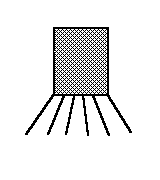
|
|
Ramified-meniscus mode
Meniscus: irregular short jets spread in random directions.
Drops: irregular fragments of liquids. |
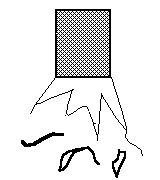
|
Ramified-jet mode
Meniscus: cone.
Jet: linear, randomly ramified.
Spray pattern: randomly spread. |
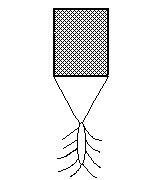
|
How to distinguish a mode of spraying?
The jet can disintegrate into droplets, while issuing from a capillary maintained at high potential, in many different ways. Several attempts, based on different criteria, have been undertaken to classify the modes of EHD spraying. However, we have not noticed in the literature a clear definition of the spraying modes, and in the following a new definition of the mode of spraying is proposed: The mode of electrohydrodynamic spraying is the way the liquid is dispersed into droplets, and is characterized by two criteria:
1. The geometrical form of the liquid at the outlet of the capillary (drop, spindle, jet),
2. The mechanism of the disintegration of the jet into droplets (type of instability).
Most of the modes of spraying, i.e., those reported in the literature and also discovered by the authors, are classified according to these criteria. Both, the geometrical shape of the jet at the outlet of a capillary and the manner by which the jet disintegrates into droplets determine the geometrical form which the sprayed aerosol assumes, and, up to certain extend, also the size of the generated droplets.
The spraying modes differ significantly in their geometrical form as observed in continuous light. These differences result from the microstructure of the jet, its formation and disintegration into droplets. Usually, each mode commences suddenly at certain voltage and flow rate, and is sustained within a certain interval of their values. Then, it abruptly changes into another mode of spraying.
The spraying modes can be divided into two groups. Into the first group are included the modes in which only fragments of liquid are ejected from the capillary directly. This group comprises: the dripping mode, microdripping mode, spindle mode, multi-spindle mode, and ramified-meniscus mode. Into the second group are included the modes in which the liquid issues a capillary in the form of a long continuous jet which disintegrates into droplets only in some distance, usually a few mm, from the outlet of the capillary. The jet can be stable or move in a certain manner. This group includes cone-jet mode, precession mode, oscillating-jet mode, multijet mode and ramified-jet mode. The ramified-jet mode was not observed by us probably because the flow rate was too low. However, this mode was reported by a few authors, for example by Cloupeau and Prunet-Foch, and for this reason was included into classification. The following considerations classify the modes of spraying and characterize most of them in terms of the jet and drop formation. The rapport extends the number of modes earlier reported in literature.
Dripping mode
The dripping mode of EHD spraying does not differ significantly from the dripping, when no voltage is applied to the capillary. The drops are formed as regular spheres detaching from the capillary as the weight of the drop and the electric force overcome the capillary forces. The exception is that with the voltage increasing the meniscus elongates and the drop becomes smaller.
The similarity extends also to the sibling generation for liquids of low viscosity. However, for higher voltages, the drop is, for a some time, connected with the capillary by a thread, which next breaks off to a few of smaller droplets. After detachment of the drop, the meniscus contracts back forming a hemispherical-like meniscus. The sibling is usually ejected perpendicular to the capillary axis because of the repulsive forces caused by the electric field generated by the potential of the capillary and the charge on the main drop.
Microdripping mode
In microdripping mode, liquid at the outlet of a capillary forms a stable meniscus, at the end of which a small, much smaller than the capillary diameter, droplet is formed. The droplet is detached from the meniscus does not undergo further disruption. This mode occurs only at low flow rates of liquid. The microdripping mode differs from the dripping mode in that the meniscus does not contract after the droplet detachment. In some cases a short filament a few micrometers in diameter coupling the main droplet with the cone can also be observed. For liquids of low viscosity, this filament breaks off under the electrostatic and inertial forces into smaller droplets. With viscous liquids the broken filament contracts both into meniscus and the detached droplet with no sibling emission. Sometimes also at the head side of the droplet a similar filament can be observed. The droplets formed from the filaments appear as fine mist around the main stream of droplets.
The size of the droplets can range from a few micrometers up to a few hundred of micrometers in diameters and the droplet size distribution is usually monodisperse. The frequency of the emission of the droplets ranges from a few up to a few thousands of droplets per second. The charge of large droplets ranged from 10 pC to 50 pC in microdripping mode, and approached a half of the Rayleigh limit.
Spindle mode
The regular drop emission is not easy to accomplish with dc excitation to the capillary, and the dripping and microdripping modes can be generated only in limited range of voltage and flow rates.
In the spindle mode, the meniscus of liquid elongates in the direction of electric field as a thick jet and detaches as a vast spindle-like fragment of liquid. Because of the shape of the jet emitted, this mode is referred to as spindle mode [11]. After detachment the spindle can disrupt into several smaller droplets of different sizes which disperse off the capillary axis. After the spindle detachment, the meniscus contracts to its initial shape and a new jet start to be formed. The spindle can be sometimes connected with the capillary by a thick thread several mm long. The thread is not linear in its form, but whips irregularly. In the case of low viscosity liquids (ethanol) also a single thin thread can be ejected from the leading side of the spindle, similar to the microdripping mode. This thread detaches from the main drop and next disrupts into several small fragments forming siblings or fine polidysperse aerosol. The spindle mode differs from the dripping mode in that no regular droplet is ejected from the meniscus but only elongated irregular fragments of liquid.
Main droplets are usually different in size, with diameters varying in the range of 300 to 1000 m m, while siblings are smaller than 100 m m. It was also noticed that main droplets are greater whereas sibling droplets become smaller with the voltage increasing. With the voltage increasing the spindle mode can change to multispindle mode with, initially, only two distinguished jets (cf. next section) or oscillating jet mode .
Multi-spindle mode
For liquids of high viscosity (for example for ethylene glycol or distilled water) a multi-spindle mode of spraying has been recorded, which has not been noticed in the literature. The dropletsí generation is similar to the spindle mode, but spindles are only emitted periodically from distinct points at the circumference of the capillary, usually in the form of a short spindle-like jet, one piece of liquid at an instant. After detachment the piece of liquid can disintegrate into a few smaller droplets. A few narrow streams around the capillary can be then distinguished in continuous illumination. These streams of droplets seem to be distributed uniformly around the axis of the capillary. The number of points of the jet emission increases with the voltage increasing. Two to four such jets are ejected from the capillary for ethylene glycol, but only two for distilled water. The spindle can be accompanied by a fine thin jet at its back and/or leading side.
The droplets generated in the multi-spindle mode are smaller in size than in the spindle mode.
Cone-jet mode
In the cone-jet mode the liquid forms a regular, axisymmetric cone with a thin jet (<100 m m in diameter) at its apex. According to Cloupeau and Prunet-Foch [11] the cone can assume three different forms: with linear sides, convex or concave. The jet flows along the capillary axis or deflects from it only on small angle usually smaller than 10o. The jet at its end undergoes instabilities. Two types of instabilities are known: varicose [15] and kink [15]. In the case of varicose instabilities, the waves are generated on the surface of the jet, but the jet does not change its linear position. In the nodes of the wave the liquid contracts and the jet disintegrates into equal droplets, which further flow close to the capillary axis. In the case of kink instabilities the whole jet moves irregularly off the axis of the capillary, with high amplitude and breaks up into series of fine droplets due to electrical and inertial forces. The aerosol is spread out off the axis, but nearly uniformly in the spray cone of an apex angle of 50-60o.
The diameter of the jet estimated from the photographs can range from a few m m to about 100 m m. The jet diameter becomes lower and its length becomes shorter with the voltage increasing. Fine droplets of mean diameter of about 30 m m or smaller are produced within this mode.
Oscillating-jet mode
In the oscillating-jet mode the continuous jet issues from the tip of the cone and changes its position (oscillates) in one plane with the capillary axis. The cone at the outlet of the capillary transits smoothly to a jet. The jet usually is not smooth, but becomes thinner at a few places. The jet disintegrates into small unequal droplets due to kink instabilities. The oscillating-jet mode differs from the cone-jet mode and precession mode, in that the jet oscillates in one plane with the capillary axis, while in the cone-jet mode the jet elongates along the capillary axis and does not move. The plane of oscillation is stable, but sometimes can change spontaneously to another orientation, or can rotate slowly around the capillary axis.
Aerosol is sprayed into a cone of an elongated ellipsoidal base and an apex angle greater than 90o. The droplets are smaller than about 200 m m in diameter.
It has been observed that a few of the dispersed droplets do not attain the surface of the counter plate but flow back to the upper electrode. They are possibly oppositely charged, because of disruption of larger droplets by the electric field in the interelectrode space. This explanation of the phenomenon needs, however, further investigations. This mode of EHD spraying can sometimes overlap with the spindle mode.
Precession mode
This mode of spraying has been originally described by the authors in papers [16-18]. In the precession mode the liquid escapes the capillary in the form of a skewed cone which changes at its apex into a thin jet of diameter smaller than 100 m m. Both the cone and the jet rotate regularly round the capillary axis, assuming a form of a fragment of a spiral. The jet becomes thinner at its end, and also rotates spirally, i.e., the end part of the jet is winding round the mother spiral. Due to the repulsive electrostatic forces, and probably also due to the centrifugal forces, the jet disintegrates into small droplets at the distance of about 5-10 mm from the tip of the capillary. The formation of the jet can be observed only in a stroboscopic light. The aerosol is nearly uniformly dispersed into the volume which assumes a form of a regular cone with the axis co-linear with the axis of the capillary. With the voltage increasing the jet becomes longer and rotates more regularly with, for example for distilled water, 200 to 300 revolutions per second,.
This mode of spraying allows to generate fine aerosol in the sizes range from 25 to 60 m m in diameter, charged to 0.1 - 0.7 pC. The size distribution does not change significantly with the voltage increasing, for this mode of spraying. The fundamental advantage of the precession mode of spraying is the uniform spatial dispersion of the aerosol and similar droplet size distributions in each point of the spray cone.
The precession mode differs from the cone-jet mode in that the jet assumes a stable linear position in the cone-jet mode, while in the precession mode, the jet rotates around the capillary axis.
Multijet mode
For liquids of low surface tension (for example for ethylene glycol or ethanol) the multijet mode of EHD spraying is observed. In the multi-jet mode the meniscus becomes flat with small cones at distinct points at the circumference of the capillary, from which fine jets of liquid are ejected. The diameter of the jets is smaller than a few of tenth of micrometers. The jets disintegrate due to kink instabilities, into small droplets, forming a fine mist around the capillary. Near the capillary, the aerosol does not fill the whole spray volume but only is dispersed in a few narrow streams which seems to be located uniformly around the axis. As has been observed, two through eight such jets are ejected from the capillary. The number of the emission points increases with the voltage increasing.
The droplets of the aerosol are smaller than a few micrometers in diameter. For distilled water the multijet mode has not been observed, probably because of the corona discharge from the capillary.
The fundamental advantage of the multijet mode of spraying is the uniform spatial dispersion of the aerosol and similar droplet size distributions in each point of the spray cone. ®









